Case Report
Critical Malfunction of Autonomous Surgical Table During Anesthesia Induction and Its Impact on AI in Medicine: Case Report
- Jorge Alberto Espinosa-Reyes MD
Corresponding author: Jorge Alberto Espinosa-Reyes, MD, ENT, Facial Plastic Surgeon Calle 127a # 7- 53 cons 3005 (INO), Bogotá, Colombia, ORCID: 0009-0008-7673-586x
Volume: 2
Issue: 5
Article Information
Article Type : Case Report
Citation : Jorge Alberto Espinosa-Reyes MD, Freddy Rodríguez MD, Gabriela Menjivar MD, Juan C. Ochoa MD, Mariana Espinosa Nieto MS3. Critical Malfunction of Autonomous Surgical Table During Anesthesia Induction and Its Impact on AI in Medicine: Case Report. Journal of Medical and Clinical Case Reports 2(5). https://doi.org/10.61615/JMCCR/2025/SEPT027140929
Copyright: © 2025 Jorge Alberto Espinosa-Reyes, MD. This is an open-access article distributed under the terms of the Creative Commons Attribution License, which permits unrestricted use, distribution, and reproduction in any medium, provided the original author and source are credited.
DOI: https://doi.org/10.61615/JMCCR/2025/SEPT027140929
Publication History
Received Date
02 Sep ,2025
Accepted Date
13 Sep ,2025
Published Date
29 Sep ,2025
Abstract
Background
Although rare, medical device failures during surgical procedures can result in severe outcomes, including fatalities. The increasing use of autonomous medical technologies introduces new risks, particularly if external control mechanisms fail during a malfunction.
Case Presentation
A 54-year-old ASA I patient with obesity and a short neck was scheduled for elective facial plastic surgery under general anesthesia. During induction, the autonomous surgical table unexpectedly shifted into a Trendelenburg position and tilted laterally, placing the anesthetized patient at risk of falling. The surgical team promptly stabilized the patient and safely transferred them to another operating room. The procedure continued without further incident. Subsequent inspection by biomedical engineers revealed a malfunction in the table’s sealed integrated circuit, which caused the autonomous movements.
Discussion
This case highlights the intersection of patient safety, obesity-related anesthetic risk, and the emerging challenges of autonomous surgical systems. While AI integration in healthcare offers significant benefits, it also introduces new vulnerabilities. Device malfunction, whether from design flaws, maintenance lapses, or software failure, can pose immediate threats in high-stakes environments. As intelligent automation advances, robust safety protocols, human oversight, and ethical frameworks must evolve in parallel to mitigate risks and ensure patient-centered care.
Conclusion
This case underscores the critical need to reassess the safety protocols surrounding autonomous surgical devices. As AI technologies become more integrated into healthcare, even minor malfunctions can lead to significant perioperative risks. Ongoing vigilance, robust device management, and proactive safety frameworks are essential to mitigate hazards and uphold patient safety in an increasingly automated clinical environment.
Key Words: Surgical table, artificial intelligence (AI), surgical tools.
►Critical Malfunction of Autonomous Surgical Table During Anesthesia Induction and Its Impact on AI in Medicine: Case Report
Jorge Alberto Espinosa-Reyes MD1*, Freddy Rodríguez MD2, Gabriela Menjivar MD3, Juan Carlos Ochoa Álvarez MD4, Mariana Espinosa Nieto, MS35
1ENT, Facial Plastic Surgeon, Calle 127a # 7- 53 cons 3005 (INO), Bogotá, Colombia, ORCID: 0009-0008-7673-586x
2Department of Anesthesiology, Calle 127a # 7- 53 (INO), Bogotá, Colombia, ORCID: 0009-0001-1470-1735
3ENT, Facial Plastic Surgery fellowship – The Face & Nose Institute. Bogotá, Colombia, ORCID: 0009-0004-7764-6050
4ENT, Facial Plastic Surgery fellowship – The Face & Nose Institute. Bogotá, Colombia, ORCID: 0009-0003-5224-0663
5Third-year Medical Student, Universidad del Rosario, Bogotá, Colombia, ORCID: 0009-0007-6808-8722
Introduction
Medical device failures during surgical procedures, while uncommon, can have serious and sometimes fatal consequences. Operating room table structural failure is a rare but potentially catastrophic event that can put patients at significant risk of serious injury or even death.[1]
The advent of advanced medical technologies, including those with autonomous functions, has introduced both benefits and new risks. These autonomous devices, designed to enhance surgical precision and efficiency, also bring potential hazards, particularly if their external control mechanisms fail during a malfunction.
In recent years, the development of electronic tables has led to significant advancements in their capability to generate greater force without the user's awareness.[2]
This report focuses on a case involving a malfunctioning surgical table that posed significant life-threatening risks to a patient undergoing elective surgery during the induction of general anesthesia. Although such incidents are rare, they underscore the crucial need for heightened awareness and preparedness among healthcare professionals.
The integration of artificial intelligence (AI) into medical equipment adds another layer of complexity. This case emphasizes the need for strict preoperative equipment checks, clear manual-override procedures, and well-rehearsed emergency protocols to ensure rapid and coordinated responses when such malfunctions occur. Preventive measures, including scheduled maintenance and multidisciplinary staff training, are essential to reduce the risk of recurrence and safeguard patient outcomes.[3]
In the rapidly evolving landscape of healthcare technology, the integration of autonomous medical devices has introduced both remarkable advancements and complex challenges.[4]
Case Report
We encountered a 54-year-old patient, weighing 120 kg and standing 1.80 meters tall, scheduled for elective surgery, which included rhinoplasty, mentoplasty, and bichectomy. During the preoperative anesthesia assessment, we noted the patient’s short neck and overweight status, which suggested a potential for difficult intubation. Despite these concerns, the patient had no significant medical history and was classified as ASA 1 (American Society of Anesthesiologists physical status classification). Thus, the procedure was approved to proceed as planned.
On the day of the surgery, our anesthesiology team performed standard checks on the anesthesia machine, ventilator, surgical table, and the availability of medications and airway management equipment. The anesthesiologist carefully monitored the patient, administering midazolam 2 mg intravenously for anxiolysis, followed by propofol 240 mg (2 mg/kg) for induction of anesthesia, and succinylcholine 120 mg (1 mg/kg) to facilitate endotracheal intubation. At the moment of intubation, an unexpected malfunction occurred: the surgical table autonomously shifted into a Trendelenburg position (see Figure 1).
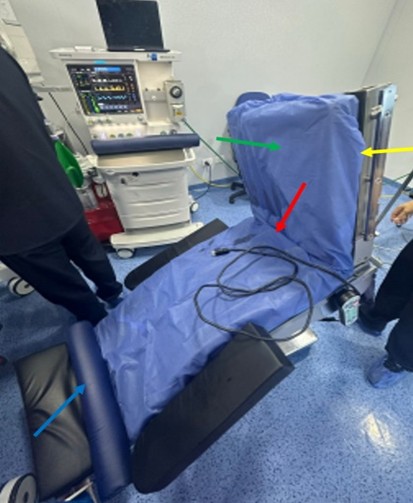
Figure 1: Surgical table with the headrest reclined. Red arrow: Show the direction of the unexpected table tilt. Yellow arrow: Point to the head section of the table. Blue arrow: Point to the foot section. Green arrow: Indicate where the patient’s head and neck were positioned during the malfunction.
This sudden movement caused the head of the table to buckle and the entire stretcher to tilt sideways, placing the patient at imminent risk of falling (see Figure 2).
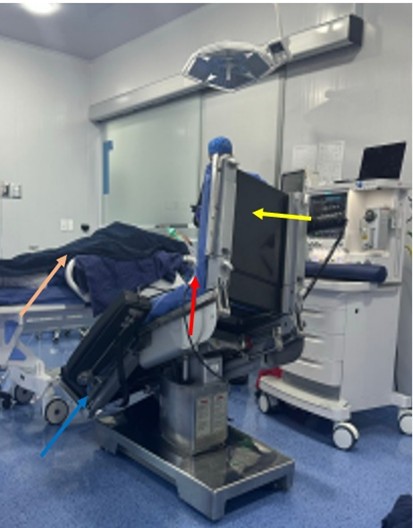
Figure 2: Surgical table with distal end elevation. View of the autonomous surgical table from a different angle, showing its malfunction position in the foreground.
Red arrow: Show the direction of the unexpected table tilt. Yellow arrow: Point to the head section of the table. Blue arrow: Point to the foot section. Orange arrow: Shows the patient hemodynamically stable after the incident, it's positioned on an auxiliary stretcher, allowing safe airway management and preparation for transfer to another operating room.
Throughout the incident, the patient remained hemodynamically stable, with heart rate maintained between 78/84 beats per minute, blood pressure ranging from 128/76 mmHg to 134/80 mmHg, oxygen saturation consistently at 99/100%, and respiratory rate between 14/16 breaths per minute. Due to the malfunction of the autonomous surgical table, the patient was carefully transferred to the floor in a controlled manner to allow safe induction and endotracheal intubation. Once secured, the patient was transported to another operating room, using an emergency stretcher. Despite the initial disruption, the scheduled surgical procedures proceeded without further complications.
Meanwhile, the malfunctioning surgical table continued to exhibit autonomous movement for approximately 30 minutes (see Figure 3). The biomedical engineering team responded promptly, conducted an inspection, and ultimately deactivated the table.
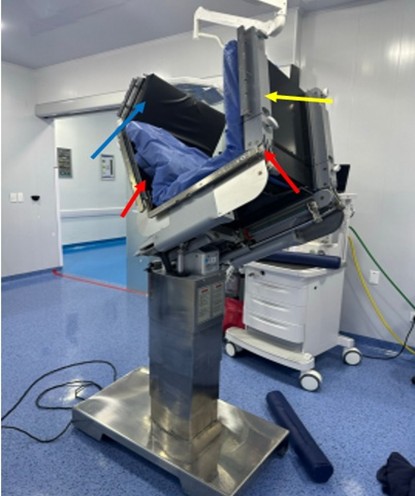
Figure 3: Surgical table in continuous movement, acquiring an elevated position. Red arrow: Show the direction of the unexpected table tilt. Yellow arrow: Point to the head section of the table. Blue arrow: Point to the foot section.
Upon thorough investigation, the engineering team identified a defect in the sealed integrated circuit unit as the cause of the table's malfunction (see Figure 4).
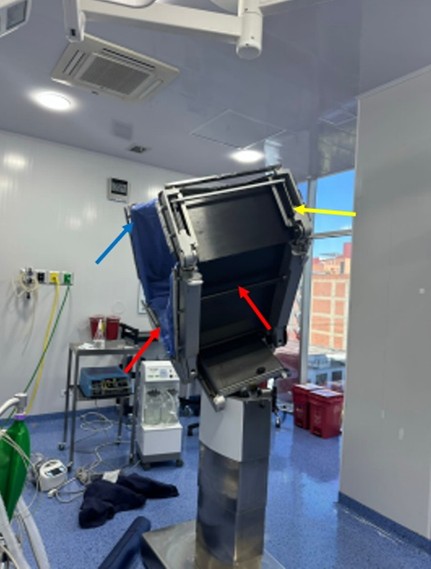
Figure 4: Final position of the surgical table. View of the autonomous surgical table from a different angle.
Red arrow: Show the direction of the unexpected table tilt. Yellow arrow: Point to the head section of the table. Blue arrow: Point to the foot section.
Discussion
Maintaining patient safety in the perioperative environment is a critical priority for healthcare providers. Identifying and addressing latent risk factors, such as the human element and organizational dynamics, is essential for reducing the likelihood of adverse events and ensuring high-quality care [5]
The prevalence of obesity has become a significant concern in the healthcare industry, particularly in the context of surgical procedures. As the number of obese patients continues to grow, healthcare providers, including anesthesiologists, surgeons, and perioperative nurses, must be well-equipped to manage the unique challenges and risks associated with this patient population.[1]
The importance of following established protocols cannot be overstated. This includes rigorous adherence to guidelines concerning the design, operation, and maintenance of medical devices. Substandard manufacturing practices or inadequate maintenance can lead to device failures, which can have serious implications for patient safety. Therefore, ongoing evaluation and improvement of device management practices are crucial to prevent incidents and safeguard patient well-being.[6]
Automation has been integrated into surgical equipment for decades, with most systems designed for specific, pre-programmed functions. Recent advancements have introduced greater levels of autonomy, enabling operating tables and other devices to perform complex, multi-axis movements without direct manual control. While these innovations can enhance efficiency and precision, they also introduce the possibility of unpredictable mechanical or control-system failures. This underscores the importance of rigorous preoperative equipment testing, established manual-override procedures, and trained staff prepared to respond to unexpected malfunctions during patient care. [7,8]
As surgical equipment incorporates increasingly advanced automation, new technical challenges and safety considerations arise. While these systems can improve efficiency and support precise patient positioning, their complexity also increases the risk of malfunction. This highlights the need for ongoing evaluation of equipment performance, strict adherence to safety protocols, and the implementation of preventive maintenance programs to ensure patient safety.[9]
The proliferation of advanced technologies in healthcare presents both opportunities and risks. Medical professionals must be equipped to manage these risks effectively, especially as the integration of autonomous systems becomes more prevalent. Ensuring comprehensive risk management strategies and adapting safety protocols will be crucial in navigating the evolving landscape of medical technology and maintaining patient safety.[10]
Conclusion
The role of external technological devices in patient safety is often underestimated, yet their failures can have serious consequences. The incident involving the malfunction of an electronic surgical table highlights the potential dangers inherent in relying on such devices. If a relatively simple technological failure can pose significant risks, the implications of a malfunction in truly autonomous systems could be even more severe.
The increasing sophistication of automated surgical equipment presents both benefits and risks in the operating room. This case of a malfunctioning autonomous surgical table during anesthesia induction underscores the importance of heightened vigilance, rapid team response, and established emergency protocols to manage unexpected equipment failures. It serves as a reminder that technological advancement must be matched by robust safety measures and staff preparedness to protect patient welfare.
Disclosures
Human subjects: Informed consent for treatment and open access publication was obtained or waived by all participants in this study. NO APPLY issued approval NO APPLY. This study did not involve human participants, identifiable data, or patient interventions. It describes the technical setup and functioning of an anesthesia workstation (‘mesa de anestesia’), and as such, no human subjects research was conducted. The institutional ethics committee reviewed the protocol and determined that ethical approval was not required under applicable regulations. No IRB approval number was issued. Conflicts of interest: In compliance with the ICMJE uniform disclosure form, all authors declare the following: Payment/services info: All authors have declared that no financial support was received from any organization for the submitted work. Financial relationships: All authors have declared that they have no financial relationships at present or within the previous three years with any organizations that might have an interest in the submitted work. Other relationships: All authors have declared that there are no other relationships or activities that could appear to have influenced the submitted work.
- McAllister, R. K, Booth, R. T, Bittenbinder, T. M. (2016). Two loose screws: near-miss fall of a morbidly obese patient after an operating room table failure. Journal Of Clinical Anesthesia. 33: 47-50.
- Albert, M, De, A. (2017). The tipping point: unanticipated dangers of operating room table position changes. Canadian Journal Of Anesthesia/Journal Canadien D Anesthésie. 64(12): 1282-1283.
- Dibekci, A, Bebek, O. (2018). Improving the Safety of Medical Robotic Systems. IEEE International Conference On Biomedical Robotics And Biomechatronics (Biorob).
- Yip, M, Salcudean, S, Goldberg, K, Althoefer, K, Menciassi, A, Opfermann, J. D, Krieger, A, Swaminathan, K, Walsh, C. J, Huang, H, Lee, I. (2023). Artificial intelligence meets medical robotics. Science. 381(6654): 141-146.
- Johnson, H. L, Kimsey, D. (2012). Patient Safety: Break the Silence. AORN Journal. 95(5): 591-601.
- Wang, B, Fedele, J, Pridgen, B, Williams, A, Rui, T, Barnett, L, Granade, C, Helfrich, R, Stephenson, B, Lesueur, D, Huffman, T, Wakefield, J. R, Hertzler, L. W, Poplin, B. (2010). Evidence-Based maintenance. Journal Of Clinical Engineering. 35(4): 223-230.
- Reyes, J. A. E, Romero, M. P, Cobo, R, Heredia, N, Ruiz, L. A. S, Zuluaga, D. A. C. (2024). Artificial Intelligence in Facial Plastic and Reconstructive Surgery: A Systematic Review. Facial Plastic Surgery. 40(5): 615-622.
- Chauhan, K, Dutt, V. (2021). Techniques of Robotics for Automation Using AI and the IoT. Artificial Intelligence Meets Medical Robotics. 129-148.
- Lambert, S. I, Madi, M, Sopka, S, Lenes, A, Stange, H, Buszello, C, Stephan, A. (2023). An integrative review on the acceptance of artificial intelligence among healthcare professionals in hospitals. Npj Digital Medicine. 6(1): 111.
- Eng, T. R. (2004). Population health technologies. American Journal Of Preventive Medicine. 26(3): 237-242.
Download Provisional PDF Here
PDF



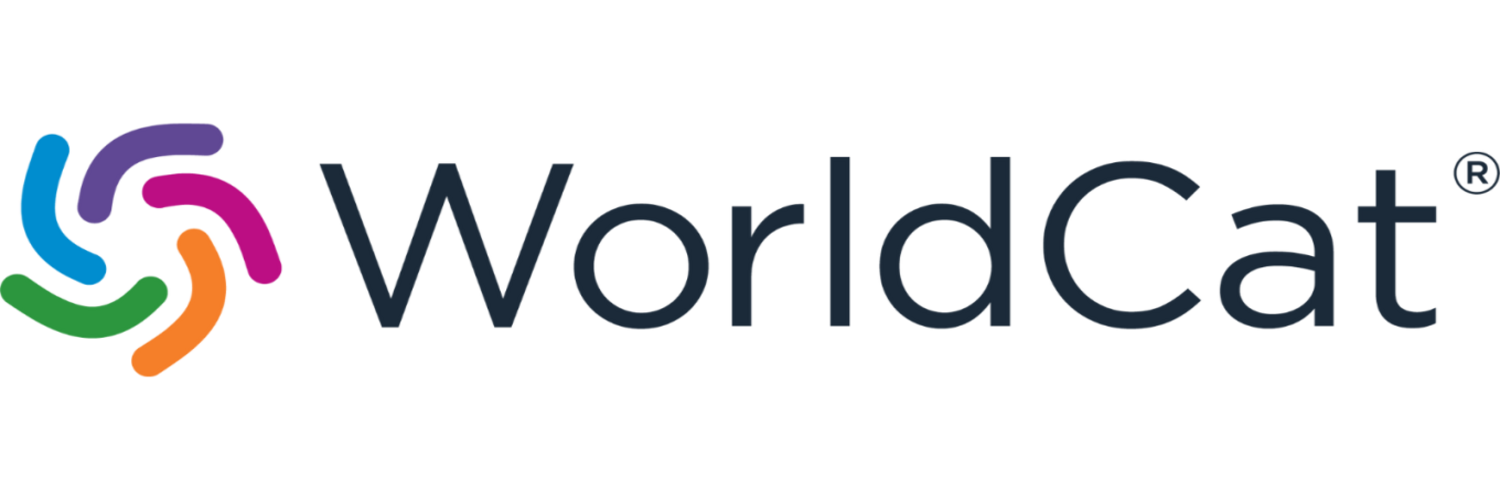
p (1).png)




.png)




.png)
